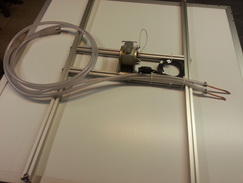|
This was the second year we used the 160 Watt solar panel on a 35 day cruise in the North Channel area of Northern Lake Huron. The boat equipment and cruising pattern was essentially the same as last year (See prior blog entries). The solar panel performance was comparable to last year with a few minor exceptions. The data comparing the performance of the 160 Watt panel during 2013 and 2014 and the 140 Watt panel in 2012 is displayed below.
Average amp hours per day produced under various conditions: 140 Watt, poly 160 Watt, mono 160 Watt, mono 2012 2013 2014 Overall average output per day 53 amp hours 48 amp hours 48 amp hours Sunny days 69 71 69 Mostly sunny days 50 50 56 Mostly cloudy days 35 37 39 Cloudy days 32 28 20 Avg. Output on days at anchor 62 61 51 Avg. Output when engine was used 43 44 45 (We had more cloudy days at anchor this year) Min amp hrs for a day 27 28 4 Max amp hrs for a day 74 77 76 Max amps output 10.5 amps 11.5 amps 11.4 amps This data is intended to provide a general idea of what to expect from the marine solar panels under various conditions. The two primary variables are the amount of sunshine and the running of the engine (the alternator charges the batteries so the controller shuts the panels down). The test boat was running a freezer/refrigerator drawing 5 amps running 6 hours a day, LED lighting, laptop computer drawing 4 amps running 3 hours a day, radios drawing 3 amps running 8 hours a day, and instruments and autopilot when under sail and power. When at anchor on a sunny to mostly sunny day our batteries were at full charge by 2 PM so we usually had excess power.
0 Comments
 Our top-of-pole solar system addresses the need for power while at anchor and under sail. In fact, we have found the solar system usually provides us an excess of electrical power while cruising. Now we find the only additional thing we need while at anchor for an extended period is warm water for showers and cleaning dishes. Sure there is the old black bag absorb the sun's heat option but this is a bit cumbersome. Then there is the option to run the engine until it heats up the water in the water heater. Running the engine for warm water is inefficient and undesirable. Now we have what promises to be a pretty good solution; solar heated water. Because the solar panel is dark in color, it absorbs a significant amount of the sun's energy in the form of heat. This is dissipated through the back and front of the panel by air currents. By attaching a heat collector/exchanger to the back of the panel, properly insulating it and circulating water through the heat exchanger we are able to collect that excess heat and store it in the water heater tank or in a separate holding tank. While still in the test stages, we have completed proof of concept and can make the heat exchangers available to DIY mariners who are interested in setting up such a system. We plan on offering a complete water heating system retro fit kit within the next year. Initial tests indicate that with our 140 and 160 watt systems we can heat 3 gallons of water from 60 to 110 degrees F in less that a half hour on a sunny day with the ambient temperature of 65 degrees F. Our top-of-pole system is about to be a 3 in 1 assembly; solar panel mount, outboard motor crane and solar water heating system. Call us if you are interested in participating in our test program. |
Categories
All
AuthorThomas Trimmer has been cruising with his Ericson 38 sailboat on the Great Lakes for over 20 years. He has pioneered the use of solar energy for wilderness cruising. He is continually designing and building equipment to simplify and enhance the cruising experience. Archives
April 2024
|
Efficiently Powering Your Vessel/Van. Call/email/chat any time, we're happy to help you work through designing your solar system.
Home Page Solar Panels Mounting Kits Product Page Marine Solar Systems Gallery of Installations Customer Comments Contact Us
Call 248 705-8337 or email [email protected]
Article On How To Size Your Solar Panels For Your Boat
Customer Reviews Return Policy Privacy Policy Shipping Times/Rates
Home Page Solar Panels Mounting Kits Product Page Marine Solar Systems Gallery of Installations Customer Comments Contact Us
Call 248 705-8337 or email [email protected]
Article On How To Size Your Solar Panels For Your Boat
Customer Reviews Return Policy Privacy Policy Shipping Times/Rates

 RSS Feed
RSS Feed